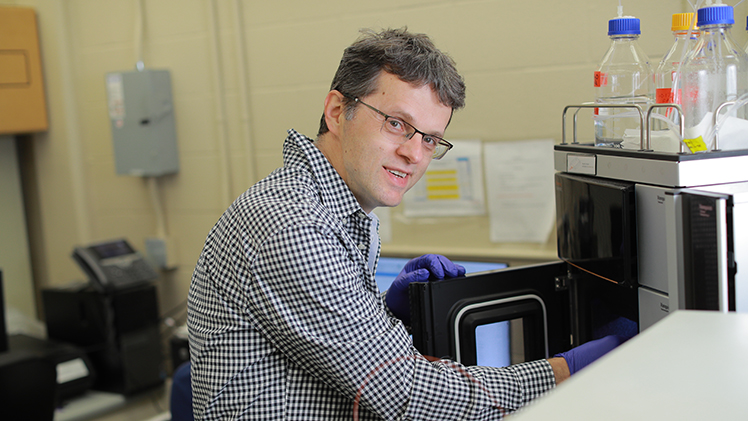By the time a harmful algal bloom began releasing toxins into western Lake Erie in August 2014, forcing the city of Toledo to issue a “Do Not Drink” water advisory for a half-million residents of northwest Ohio and southeast Michigan, scientists knew of more than 100 different types, or congeners, of the best-known class of cyanobacterial toxins called microcystins.
In the decade since this water crisis, they’ve tripled their count to more than 300.

Dr. Dragan Isailovic, a professor in the Department of Chemistry and Biochemistry, will use advanced bioanalytical and biophysical chemistry techniques to identify new congeners of microcystins and other classes of toxins in new research supported by the National Institute of Environmental Health Sciences.
And in the Maumee River and western Lake Erie, they’re counting on.
“Each congener has a different structure and a different toxicity,” said Dr. Dragan Isailovic, a professor in the Department of Chemistry and Biochemistry at The University of Toledo. “It’s important that we understand the unique characteristics of each one so that we can make appropriate decisions regarding water usage and treatment during the harmful algal blooms that we experience year after year in Lake Erie and in inland lakes in Ohio.”
Isailovic will use advanced bioanalytical and biophysical chemistry techniques to identify new congeners of microcystins and other classes of toxins in new research supported by the National Institute of Environmental Health Sciences, which recently awarded him $459,353 under its Biological Response to Environmental Health Hazards program.
He is collaborating with co-principal investigators Dr. David Kennedy and Dr. Steven Haller, associate professors of medicine at UToledo, and Dr. Judy Westrick, director of the Lumigen Instrument Center at Wayne State University, on the work that has potential to lay the groundwork for new cyanotoxin detection strategies in the western basin of Lake Erie.
“I would like to congratulate Dr. Isailovic on this significant award from the NIH National Institute of Environmental Health Sciences,” said Dr. Marc Seigar, dean of the UToledo College of Natural Sciences and Mathematics. “Dr. Isailovic and others are doing critical work in the area of water quality to make sure Toledo does not suffer from another water crisis like the one we faced 10 years ago.”
“I am immensely proud of The University of Toledo and Dr. Isailovic for their commitment to pioneering research that addresses critical environmental issues affecting our Great Lakes region. This award is a testament to their exceptional work and dedication to improving public health and safeguarding our natural resources,” said Congresswoman Marcy Kaptur. “I look forward to seeing the advancements and insights this project will bring to light as we continue to combat the impacts of harmful algal blooms on Lake Erie. Our Great Lakes are a precious natural endowment. We must do everything in our power to protect this treasure so important to our region of northwest Ohio.”
As a member of the UToledo Water Task Force, which brought together a team of scientists, engineers, doctors and public health experts in the immediate wake of the water crisis in 2014, Isailovic is well versed in the chemistry of the cyanobacteria that mass to form harmful algal blooms and the toxins they release when their cell membranes break down in a process called lysis.
It’s these toxins that account for the “harmful” descriptor in a harmful algal bloom.
But what this release of toxins looks like can vary significantly between any two blooms, with several factors — including congeners present — contributing to the ultimate toxicity.
In their new research supported by the National Institute of Environmental Health Sciences, Isailovic and his collaborators will analyze samples collected from the Maumee River and western Lake Erie with assistance from the research group of Dr. Thomas Bridgeman, a professor in the Department of Environmental Sciences and director of UToledo Lake Erie Center. They plan to refine a process to identify and document novel congeners, using liquid chromatography to separate and isolate them and mass spectrometry and fluorescence to analyze them.
The new research builds on a just-completed project under the Ohio Department of Higher Education’s Harmful Algal Bloom Research Initiative, in which Isailovic and his collaborators employed similar techniques to establish a database on cyanotoxin identities, distribution and toxicity in the Maumee River and western Lake Erie.
Isailovic gave credit to the funding organizations, the departmental staff that has helped with the maintenance of sophisticated analytical instruments and the collaborators and students who have worked on the bloom-related projects. Dr. Sharmila Thenuwara, a recent doctoral and postdoctoral researcher, and Sanduni Premathilaka, a doctoral candidate, assisted Isailovic immensely with the research under the Harmful Algal Bloom Research Initiative.
Isailovic said student involvement is a key element of the new research as well. The grant will support one graduate and two undergraduate students.
“It’s important collaborative research, but it’s also important opportunity to train the students who will become experts in the identification of novel cyanotoxins and studying their toxic effects, and contribute to educational and societal efforts related to the protection of our water resources and environmental health during harmful algal blooms,” he said.